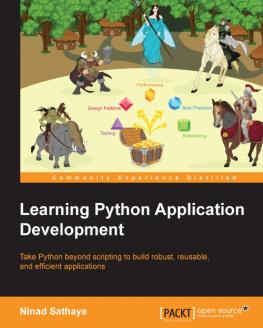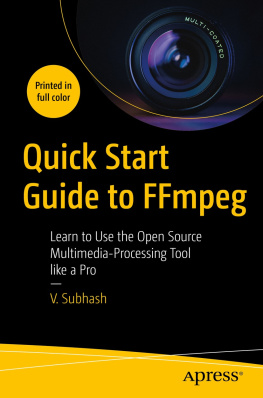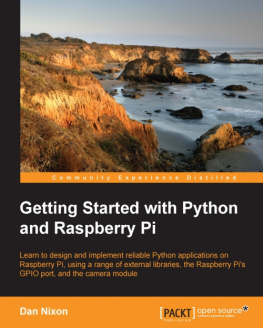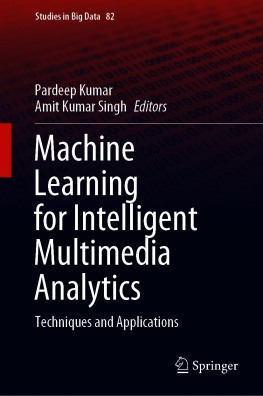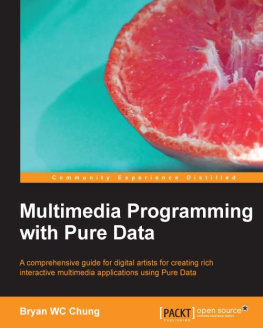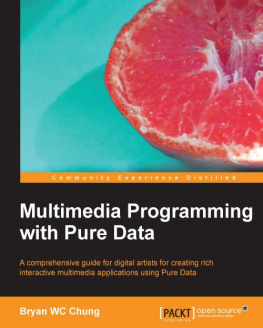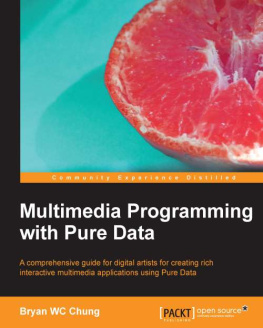Ninad Sathaye - Python Multimedia Application Beginners Guide : Learn How to Develop Multimedia Applications Using Python with This Practical Step-by-Step Guide
Here you can read online Ninad Sathaye - Python Multimedia Application Beginners Guide : Learn How to Develop Multimedia Applications Using Python with This Practical Step-by-Step Guide full text of the book (entire story) in english for free. Download pdf and epub, get meaning, cover and reviews about this ebook. City: Birmingham, year: 2010, publisher: Packt Publishing, Limited, genre: Computer. Description of the work, (preface) as well as reviews are available. Best literature library LitArk.com created for fans of good reading and offers a wide selection of genres:
Romance novel
Science fiction
Adventure
Detective
Science
History
Home and family
Prose
Art
Politics
Computer
Non-fiction
Religion
Business
Children
Humor
Choose a favorite category and find really read worthwhile books. Enjoy immersion in the world of imagination, feel the emotions of the characters or learn something new for yourself, make an fascinating discovery.
- Book:Python Multimedia Application Beginners Guide : Learn How to Develop Multimedia Applications Using Python with This Practical Step-by-Step Guide
- Author:
- Publisher:Packt Publishing, Limited
- Genre:
- Year:2010
- City:Birmingham
- Rating:3 / 5
- Favourites:Add to favourites
- Your mark:
Python Multimedia Application Beginners Guide : Learn How to Develop Multimedia Applications Using Python with This Practical Step-by-Step Guide: summary, description and annotation
We offer to read an annotation, description, summary or preface (depends on what the author of the book "Python Multimedia Application Beginners Guide : Learn How to Develop Multimedia Applications Using Python with This Practical Step-by-Step Guide" wrote himself). If you haven't found the necessary information about the book — write in the comments, we will try to find it.
Multimedia applications are used by a range of industries to enhance the visual appeal of a product. This book will teach the reader how to perform multimedia processing using Python.
This step-by-step guide gives you hands-on experience for developing exciting multimedia applications using Python. This book will help you to build applications for processing images, creating 2D animations and processing audio and video.
Writing applications that work with images, videos, and other sensory effects is great. Not every application gets to make full use of audio/visual effects, but a certain amount of multimedia makes any application a lot more appealing. There are numerous multimedia libraries for which Python bindings are available. These libraries enable working with different kinds of media, such as images, audio, video, games, and so on. This book introduces the reader to the most widely used open source libraries through several exciting, real world projects. Popular multimedia frameworks and libraries such as GStreamer, Pyglet, QT Phonon, and Python Imaging library are used to develop various multimedia applications.
Learn how to develop Multimedia applications using Python with this practical step-by-step guide. Read more...
Abstract: Annotation.
Multimedia applications are used by a range of industries to enhance the visual appeal of a product. This book will teach the reader how to perform multimedia processing using Python.
This step-by-step guide gives you hands-on experience for developing exciting multimedia applications using Python. This book will help you to build applications for processing images, creating 2D animations and processing audio and video.
Writing applications that work with images, videos, and other sensory effects is great. Not every application gets to make full use of audio/visual effects, but a certain amount of multimedia makes any application a lot more appealing. There are numerous multimedia libraries for which Python bindings are available. These libraries enable working with different kinds of media, such as images, audio, video, games, and so on. This book introduces the reader to the most widely used open source libraries through several exciting, real world projects. Popular multimedia frameworks and libraries such as GStreamer, Pyglet, QT Phonon, and Python Imaging library are used to develop various multimedia applications.
Learn how to develop Multimedia applications using Python with this practical step-by-step guide
Ninad Sathaye: author's other books
Who wrote Python Multimedia Application Beginners Guide : Learn How to Develop Multimedia Applications Using Python with This Practical Step-by-Step Guide? Find out the surname, the name of the author of the book and a list of all author's works by series.


